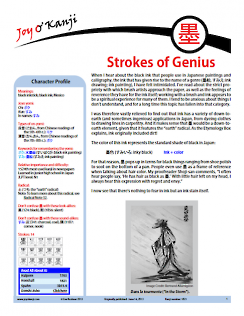墨
black inkstick; black ink; Mexico
Kanji 1821
Thank you for visiting this Character Home Page. Below you'll find a synopsis of the essay. If you wish to read the full text, the PDF of the essay is available for purchase to the right.
Black ink has left an indelible mark on Japanese culture. People have used it to dye clothes, modify their bodies (e.g., tattoos), and censor information. Find out how the Japanese make solid and liquid ink and how they view brushstrokes as a mirror of the mind. Also learn about sumi-e (ink paintings) and enjoy gorgeous sumi-e from talented artists around the globe.
Revision history:
Nov. 27, 2024: p. 10: Deleted a sentence that no longer seems valid. I had said, "writing this word as 刺青 suggests that tattoos are blue (which they aren't), rather than black (which they are)." In fact, tattoos can now be any color.
Aug. 29, 2024: p. 13, sidebar: Replaced a broken link and removed surrounding text that no longer applied. Also added information about the Redact tool in Adobe Acrobat and the Japanese name of that function.
Mar. 29, 2024: pp. 15-16: Deleted all links to Mariusz Szmerdt's now-defunct website, plus two more broken links to another site.
Sept. 8, 2023: p. 5: Fixed a typo.
Apr. 25, 2022: p. 9: Enhanced the listing for 眉墨, as well as the discussion about it.
June 15, 2021:
- p. 2: Updated the Henshall etymology.
- p. 21: Added a link to the Kanshudo games.
Mar. 31, 2018: p. 12: Slightly revised the explanation of the Chinese proverb.
Jan. 27, 2018:
- pp. 3, 4, 15, 16, 21, 22: Fixed broken links.
- p. 11: Slightly revised a sentence to reflect that some people still use the tool known as a 墨壺.
- p. 17 sidebar: Slightly revised the sample sentence translation.
June 22, 2013: p. 11: Changed a breakdown. Also changed one instance of 壷 to its variant, 壺, for consistency.
June 15, 2013: Originally published.



Comments